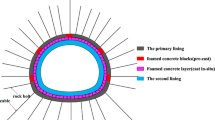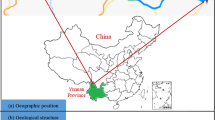Abstract
Second lining stability, which is the last protection in tunnel engineering, is critically important. The rheological properties of the surrounding rock heavily affect second lining stability. In this work, we used laboratory triaxial compressive rheological limestone tests to study nonlinear creep damage characteristics of surrounding rock mass in construction projects. We established a nonlinear creep damage constitutive model for the rock mass, as well as a constitutive model numerical implementation made by programming. Second, we introduced a new foam concrete with higher compression performance and good ductility and studied its mechanical properties through uniaxial and triaxial tests. This concrete was used as the filling material for the reserved deformation layer between the primary support and second lining. Finally, we proposed a high efficiency and accuracy staged optimization method. The minimum reserved deformation layer thickness was established as the optimization goal, and the presence of plastic strain in the second lining after 100 years of surrounding rock creep was used as an evaluation index. Reserved deformation layer thickness optimization analysis reveals no plastic strain in the second lining when the reserved deformation minimum thickness layer is 28.50 cm. The results show that the new foam concrete used as a reserved deformation layer filling material can absorb creep deformation of surrounding rock mass, reduce second lining deformation that leads to plastic strain, and ensure long-term second lining stability.
Similar content being viewed by others
References
BRANTUT N, HEAP M J, MEREDITH P G, BAUD P. Time-dependent cracking and brittle creep in crustal rocks: A review [J]. Journal of Structural Geology 2013, 52(1): 17–43.
ZHOU Xiao-ping, HOU Qing-hong, QIAN Qi-hu, ZHANG Yong-xing. The zonal disintegration mechanism of surrounding rock around deep spherical tunnels under hydrostatic pressure condition: A non-Euclidean continuum damage model [J]. Acta Mechanica Solida Sinica 2013, 26(4): 373–387.
MALAN D F. Time-dependent behaviour of deep level tabular excavations in hard rock [J]. Rock Mechanics and Rock Engineering 1999, 32(2): 123–155.
ZHANG Yu, XU Wei-ya, GU Jin-jian, WANG Wei. Triaxial creep tests of weak sandstone from fracture zone of high dam foundation [J]. Journal of Central South University 2013, 20(9): 2528–2536.
NOMIKOS P, RAHMANNEJAD R, SOFIANOS A. Supported axisymmetric tunnels within linear viscoelastic burgers rocks [J]. Rock Mechanics and Rock Engineering 2011, 44(5): 553–564.
SHAO Jian-fu, CHAU K T, FENG X T. Modeling of anisotropic damage and creep deformation in brittle rocks [J]. International Journal of Rock Mechanics and Mining Sciences 2006, 43(4): 582–592.
LIN Jie-wei, ZHANG Jun-hong, ZHANG Gui-chang, NI Guang-jian, BI Feng-rong. Aero-engine blade fatigue analysis based on nonlinear continuum damage model using neural networks [J]. Chinese Journal of Mechanical Engineering 2012, 25(2): 338–345.
ROSSIKHIN Y A, SHITIKOVA M V. Free damped vibrations of a viscoelastic oscillator based on Rabotnov’s model [J]. Mechanics of Time-Dependent Materials 2008, 12(2): 129–149.
ZHANG Cheng-qing. Granite in the damage evolution of the stress wave effect of experimental research [D]. Beijing: China University of Mining & Technology, 2014. (in Chinese)
LOKOSHCHENKO A M. Results of studying creep and long-term strength of metals at the Institute of Mechanics at the Lomonosov Moscow State University [J]. Journal of Applied Mechanics and Technical Physics 2014, 55(1): 118–135.
LEMAITRE J. A course on damage mechanics [M]. Springer Verlag, 1992: 87–95.
DENG Bin, SHEN Zhi-bin, DUAN Jing-bo, TANG Guo-jin. Finite element method for viscoelastic medium with damage and the application to structural analysis of solid rocket motor grain [J]. Science China (Physics, Mechanics & Astronomy) 2014, 57(5): 908–915.
HIBBITT D, KARLSSON B, SORENSEN P. ABAQUS/Standard user subroutines reference manual [M]. USA: The Pennsylvania State University, 2003: 50–62.
MA Yu-li, SU Xian-yue, PYRZ R, RAUHE J C. A novel theory of effective mechanical properties of closed-cell foam materials [J]. Acta Mechanica Solida Sinica 2013, 26(6): 559–569.
CHRISTENSEN R M. Mechanics of cellular and other low-density materials [J]. International Journal of Solids and Structures 2000, 37(1): 93–104.
GIBSON L J, ASHBY M F. Cellular solids: Structure and properties [M]. Oxford: Pergamon Press, 1988: 108–121.
GARSTECKI A, GLEMA A, LODYGOWSKI T. Sensitivity of plastic strain localization zones to boundary and initial conditions [J]. Computational Mechanics 2003, 30(2): 164–169.
YANG Xiao-li, JIN Qi-yun, MA Jun-qiu. Pressure from surroun DING rock of three shallow tunnels with large section and small spacing [J]. Journal of Central South University 2012, 19(8): 2380–2385.
YANG Xiao-li, ZHANG Jia-hua, JIN Qi-yun, MA Jun-qiu. Analytical solution to rock pressure acting on three shallow tunnels subjected to unsymmetrical loads [J]. Journal of Central South University 2013, 20(2): 528–535.
HAGE C F, SHAHROUR I. Numerical analysis of the interaction between twin-tunnels: Influence of the relative position and construction procedure [J]. Tunnelling and Underground Space Technology 2008, 23(2): 210–214.
ADDENBROOKE T I, POTTS D M. Twin tunnel interaction: Surface and subsurface effects [J]. International Journal of Geomechanics 2001, 1(2): 249–271.
KARAKUS M, OZSAN A, BASARIR H. Finite element analysis for the twin metro tunnel constructed in Ankara Clay-Turkey [J]. Bulletin of Engineering Geology and the Environment 2007, 66(1): 71–79.
LEE Y Z, SCHUBERT W. Determination of the round length for tunnel excavation in weak rock [J]. Tunnelling and Underground Space Technology 2008, 23(3): 221–231.
Author information
Authors and Affiliations
Corresponding author
Additional information
Foundation item: Projects(51409154, 41372289 ) supported by the National Natural Science Foundation of China; Projects(2015JQJH106, 2014TDJH103) supported by Research Fund of Shandong University of Science and Technology, China
Rights and permissions
About this article
Cite this article
Wang, H., Chen, Wz., Wang, Qb. et al. Rheological properties of surrounding rock in deep hard rock tunnels and its reasonable support form. J. Cent. South Univ. 23, 898–905 (2016). https://doi.org/10.1007/s11771-016-3137-6
Received:
Accepted:
Published:
Issue Date:
DOI: https://doi.org/10.1007/s11771-016-3137-6




